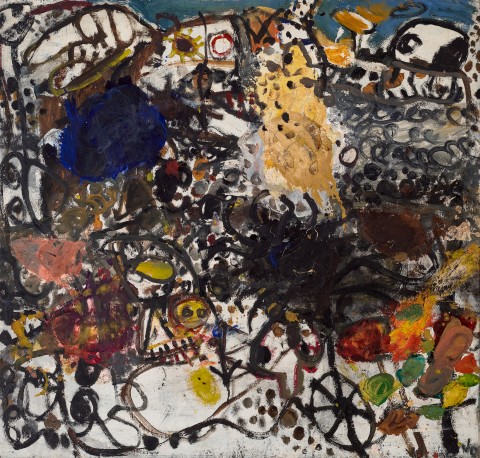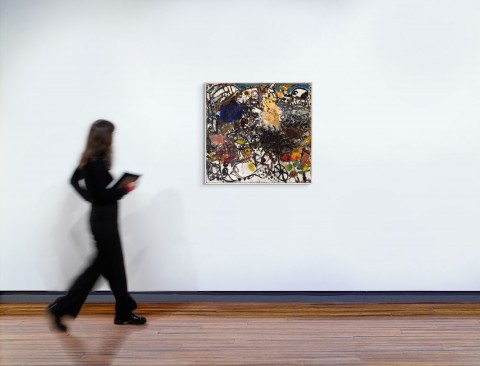AUSTRALIAN LANDSCAPE, 1962
JOHN OLSEN
oil on composition board
87.0 x 91.0 cm
signed with initials lower right: J O
Private collection, USA
Sotheby's, Sydney, 28 August 2006, lot 102
John Barnes, Melbourne, acquired from the above
The Estate of John Barnes, Melbourne
McGregor, K., and Zimmer, J., John Olsen: Journeys Into the You Beaut Country, Thames & Hudson, Melbourne, 2016, pp. 30 – 31 (illus.), 337
We are grateful to Kylie Norton, Editor, John Olsen Catalogue Raisonné, for her assistance with this catalogue entry.
When John Olsen departed Australia for Europe in 1957, he left one European tradition behind and embraced another. In Sydney he had studied under John Passmore, a disciplinarian with a steadfast interest in Cezanne. In France, and eventually Spain, Olsen encountered a mid-20th century avant-garde, a free-wheeling and expressive attitude, his natural temperament, which shaped his art for the remainder of his life.
Olsen saw the lyrical, gestural and frequently wilful expressive work of artists connected with Art Informel and Tachisme. They discarded the formal elements of the modernists a generation before them – Cubism was their anathema. After a few months in Paris where he studied etching under S.W. Hayter, Olsen went to Deià, a village in Majorca in 1958. In Spain, Olsen saw the work of Antoni Tàpies (1923 – 2012) whose paintings applied various materials, surfaces were scratched, gouged and brushed marks were often inspired by neighbourhood graffiti.
Olsen was attracted to the dark temperament of Spanish painting as a way in which to express observed life at. ‘The Spanish lineage did not explain itself in floral tributes but in blacks, leather browns, burnt reds, blood like crimsons, chamois and candle whites.’1
From portraits to The Disasters of War, Goya’s art is an obvious marker of this quality.
Australia is the embodiment of a defining moment, one which foreshadowed Olsen’s approach to art which would evolve over decades. Lineal painterliness is sometimes described as calligraphic, too often a loosely applied catch-all. In this work we see it as a precise description. Paint is applied wet over dry, gestures, sweeps and considered daubs are placed with a pigment-loaded brush and done in one action without carefully nuanced halftones. Everything is confident and conveys the power of deliberateness without a skerrick of timidity or hesitation.
Olsen had begun reading about Zen Buddhism, and in his journal of 1958, he wrote, ‘…Zen realises that our nature is at one with objective nature… in the sense that we live in nature and nature lives within us…attuning the mind to the utmost fluidity or mobility, to acquire the spontaneity of natural growth.’ This might not only have been a note relevant for its time, but also a prescient encapsulation of his whole career.
Olsen returned to Australia in 1960 and soon after painted Spanish Encounter, a vast triptych, and the Art Gallery of New South Wales purchased it before year’s end. The expansive, black-brushed drawing clearly connects with the surface personality in Australian Landscape. It also echoes the brooding dramatic darkness of Granada, 1959 (National Gallery of Victoria).
In Olsen’s Journey into the You Beaut Country paintings of 1961 his palette lightens, and we see an openness and painterly spontaneity where all elements are choreographed across the surface.
Within this context, Australian Landscape, 1962 is a critically important painting – one which not only marks a shift in Olsen’s early career, but notably anticipates work for the following decades.
1.John Olsen cited in ‘Interview with Maudie Palmer’ in In Search of Open Country 1961 – 1986, Heide Park and Art Gallery, Melbourne, 1986, p.7
DOUG HALL AM


